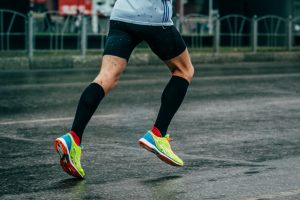When you watch a major race such as the Boston Marathon, you may notice that the gear the elite runners wear differs from the shorts and tank top you throw on for a casual run. In particular, compression socks and calf sleeves have become a popular part of the elite runner look. Adopting these compression garments could give you an advantage in your running training.
What Are Compression Garments?
As their name suggests, compression socks or sleeves are tight garments that are worn while running. These socks are typically made of breathable materials such as polyester, nylon, Lycra, Spandex or Coolmax. This ensures that the gear compresses your body without making you a sweaty mess. Compression socks typically climb partway up the leg (or sometimes all the way to the knee). In contrast, compression calf sleeves are slid over the leg to compress the calf without including the foot. These can be worn with regular running socks.
making you a sweaty mess. Compression socks typically climb partway up the leg (or sometimes all the way to the knee). In contrast, compression calf sleeves are slid over the leg to compress the calf without including the foot. These can be worn with regular running socks.
Advantages of Compression Socks and Calf Sleeves
For years, our orthopedic doctors have been recommending compression socks for people recovering from surgery. The rationale behind these socks is that they gently squeeze the legs, promoting stronger blood flow. For runners, this increased blood flow can result in greater delivery of nutrients to muscle tissue as well as a reduction in the buildup of lactic acid.
People who use compression running garments say that they improve running performance. Some people use compression socks during a run while others wear them following a run to improve recovery. Regardless of when you choose to wear them, compression garments may reduce the swelling that occurs following a long run.
Disadvantages of Wearing Compression Garments
There are no real disadvantages of wearing compression garments while running. It simply comes down to personal preference. Some runners find the sensation of compression garments distracting, particularly if they have been training intensely without these garments. However, it cannot hurt to give compression socks or sleeves a try. Simply find a pair that feels tight without squeezing your legs to the point of discomfort.
Of course, compression socks or calf sleeves are just one part of a balanced approach to running. Without proper training practices and running form, you significantly increase your risk of a running-related injury. If you have an injury that has been bothering you, it is best to get it checked out immediately. Our sports medicine orthopedic specialists are trained to understand runners’ unique orthopedic needs and to help you prevent future injury.
Return to Blog